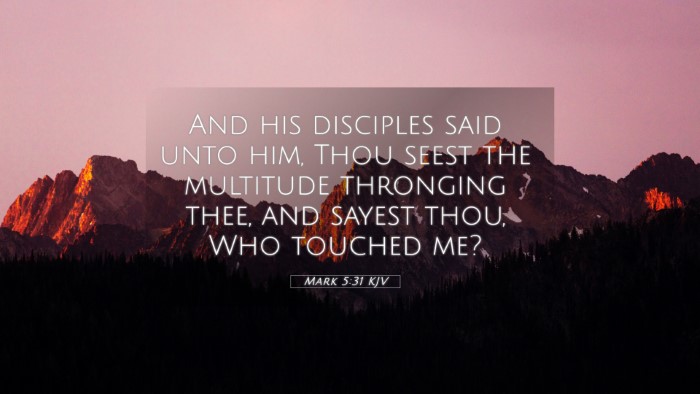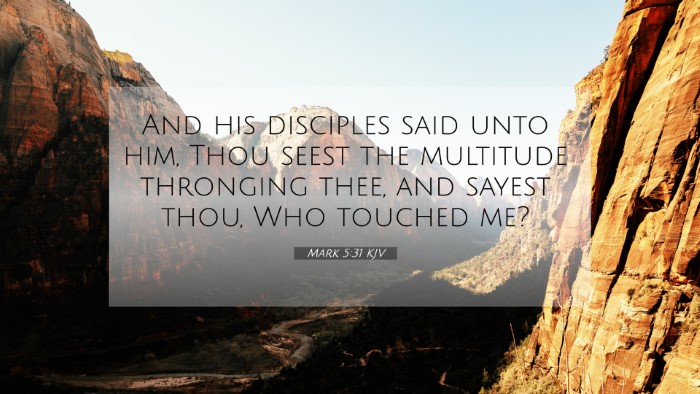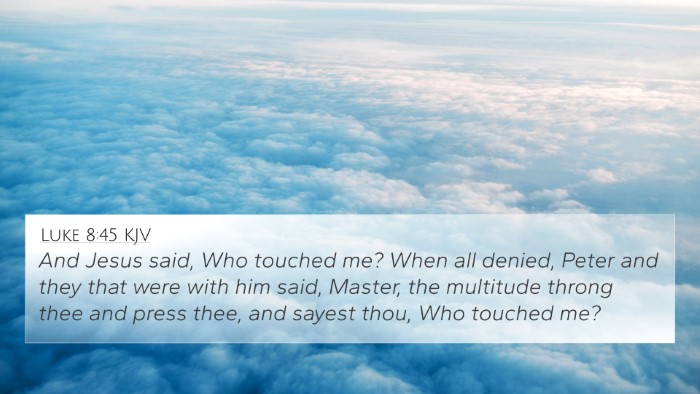Understanding Mark 5:31: A Comprehensive Analysis
Mark 5:31 states: "And His disciples said to Him, 'You see the multitude thronging You, and You say, 'Who touched Me?'" This verse captures an important moment during Jesus' ministry, emphasizing the insights from various public domain commentaries related to its interpretation.
Contextual Background
This verse occurs in the context of Jesus healing a woman with an issue of blood and raising Jairus' daughter from the dead. The narrative illustrates not only the miraculous power of Jesus but also highlights the disciples' misunderstanding of His awareness of individual needs amidst a crowd.
Commentary Insights
- Matthew Henry: Henry notes the contrast between the disciples' perception and Jesus' divine insight. While the disciples perceive the multitude and question why Jesus is asking who touched Him, Henry highlights that Jesus is always aware of individual faith and needs. He emphasizes the effectiveness of personal faith in the midst of great crowds.
- Albert Barnes: Barnes points out the disciples' reaction as indicative of a common human response in recognizing the miraculous. He describes how the thronging crowd demonstrates a human inclination to seek Jesus for various needs but fails to perceive the spiritual depth of personal connection with Him.
- Adam Clarke: Clarke interprets this moment as essential in illustrating Jesus’ ability to sense the touch of faith among many. He emphasizes the personal nature of faith, signifying that Jesus discerned the one who reached out to Him with sincerity.
Thematic Connections
The verse provides a profound theme of individual faith in the midst of collective need. Notably, this theme resonates through various Scriptures, showcasing connections between Bible verses.
Cross-References for Mark 5:31
- Luke 8:43-48 - The healing of the woman with the issue of blood, providing a parallel account.
- Matthew 9:20-22 - Another parallel account of the woman who touched the hem of Jesus’ garment.
- John 10:14 - Jesus as the Good Shepherd who knows His sheep personally.
- Isaiah 53:5 - The prophecy of healing through the suffering of Christ.
- Hebrews 4:15 - Christ's empathy towards human struggles and afflictions.
- James 5:14-15 - The call for the sick to seek healing through faith and prayer within the community of believers.
- Matthew 7:7 - The encouragement to seek, asking in faith leads to receiving from God.
- Mark 10:51 - Blind Bartimaeus calls out to Jesus, demonstrating personal faith amidst a crowd.
Tools for Understanding Cross-References
Comprehending cross-references requires tools and systems that enhance biblical understanding:
- Bible Concordance: A useful resource for finding verses related to specific terms or themes.
- Bible Cross-Reference Guide: Guides that can help identify verses that relate to each other thematically.
- Bible Reference Resources: Tools to provide context and connection among various scriptures.
- Cross-Referencing Bible Study Methods: Methods that encourage deeper exploration of scriptural links.
- Bible Chain References: Studying chains of references that connect verses on specific topics.
The Importance of Cross-Referencing
Cross-referencing provides an avenue for individuals to explore connections between Old and New Testament scriptures. For example, understanding the predictive prophecy in Isaiah 53 enriches the understanding of Jesus' healing ministry as exemplified in Mark 5:31. It allows for a comparative Bible verse analysis that bolsters faith through the recognition of God’s continuous revelation.
How to Conduct Cross-Referencing in the Bible
When studying Bible verses, consider:
- Identifying Connections: Look for similar phrases, themes, or theological implications.
- Utilizing Software: There are many digital tools that facilitate finding cross-references effectively.
- Community Study: Discussing verses with others can reveal connections you might not have seen alone.
- Sermon Preparation: Cross-referenced themes improve the depth and clarity of sermons.
- Personal Reflection: Taking the time to meditate on how scriptures relate can enhance personal faith.
Conclusion
Mark 5:31 invites readers to appreciate the deep connections in Scripture. The insights from public domain commentaries help unravel the meaning behind the disciples' misunderstanding and highlight the individual's faith in the presence of Jesus. Cross-referencing offers multiple pathways to enrich one's understanding of biblical text, affirming the interconnectedness of God's Word.




